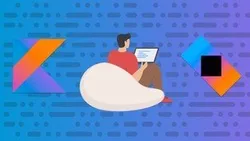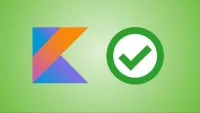
Intermediate Android: Jump Scare App Clone In Kotlin 
Create a prank app of your own with this tutorial on Intermediate Android development. Learn how to use Kotlin to clone the popular Shock app and create your own jump scare. ▼
ADVERTISEMENT
Course Feature
![]() Cost:
Cost:
Free
![]() Provider:
Provider:
Udemy
![]() Certificate:
Certificate:
No Information
![]() Language:
Language:
English
![]() Start Date:
Start Date:
On-Demand
Course Overview
❗The content presented here is sourced directly from Udemy platform. For comprehensive course details, including enrollment information, simply click on the 'Go to class' link on our website.
Updated in [April 29th, 2023]
This course is designed to teach users the techniques used in the prank app Shock. It covers topics such as storing objects in Shared Preferences, downloading images to app storage, and working with TextToSpeech. It is not a beginner course and is intended for those who are comfortable programming Android apps and want to explore new possibilities.
Possible Development Directions:
This course provides users with the opportunity to learn how TempestStorm pulled off some of the techniques in the prank app Shock. It covers topics such as downloading images from the web, saving objects into Shared Preferences, using LocalBroadcastManager to inform parts of the app to update itself, and using MediaPlayer to play scary sounds. It also provides users with the opportunity to learn how to use TextToSpeech to add a unique touch to the app.
Related Learning Suggestions:
This course is the Kotlin version of the course. If users know Java, there is a Java version of the course. Additionally, users are encouraged to download and rate the app, as it helps.
[Applications]
Students will have a better understanding of the techniques used in the Shock prank app. They will be able to store objects in Shared Preferences, download images to app storage, and work with TextToSpeech. Students will also be able to create their own prank apps using the techniques they have learned. Additionally, they will be able to apply the same techniques to other Android apps.
[Career Paths]
1. Android Developer: Android developers are responsible for developing applications for devices powered by the Android operating system. They are responsible for the development, testing, and deployment of applications. Android developers must have a strong understanding of the patterns and practices that revolve around the Android platform. They must also be familiar with the latest technologies and trends in mobile development. With the increasing demand for mobile applications, the demand for Android developers is also increasing.
2. Mobile Application Designer: Mobile application designers are responsible for creating user-friendly and aesthetically pleasing mobile applications. They must have a strong understanding of user experience and interface design principles. They must also be familiar with the latest trends in mobile application design. With the increasing demand for mobile applications, the demand for mobile application designers is also increasing.
3. Mobile Application Tester: Mobile application testers are responsible for testing mobile applications for bugs and other issues. They must have a strong understanding of the mobile application development process and be familiar with the latest technologies and trends in mobile application testing. With the increasing demand for mobile applications, the demand for mobile application testers is also increasing.
4. Mobile Application Developer: Mobile application developers are responsible for developing mobile applications for various platforms. They must have a strong understanding of the mobile application development process and be familiar with the latest technologies and trends in mobile application development. With the increasing demand for mobile applications, the demand for mobile application developers is also increasing.
[Education Paths]
1. Bachelor of Science in Computer Science: This degree path focuses on the fundamentals of computer science, such as programming, software engineering, and computer architecture. It also covers topics such as artificial intelligence, data structures, and algorithms. This degree path is ideal for those interested in developing and maintaining software applications, as well as those interested in exploring the possibilities of artificial intelligence and machine learning. The developing trend in this field is the increasing use of artificial intelligence and machine learning in software development.
2. Master of Science in Software Engineering: This degree path focuses on the design and development of software applications. It covers topics such as software architecture, software testing, and software project management. This degree path is ideal for those interested in developing and maintaining software applications, as well as those interested in exploring the possibilities of artificial intelligence and machine learning. The developing trend in this field is the increasing use of artificial intelligence and machine learning in software development.
3. Bachelor of Science in Information Technology: This degree path focuses on the fundamentals of information technology, such as networking, database management, and web development. It also covers topics such as security, cloud computing, and mobile application development. This degree path is ideal for those interested in developing and maintaining software applications, as well as those interested in exploring the possibilities of artificial intelligence and machine learning. The developing trend in this field is the increasing use of artificial intelligence and machine learning in software development.
4. Master of Science in Artificial Intelligence: This degree path focuses on the fundamentals of artificial intelligence, such as machine learning, natural language processing, and computer vision. It also covers topics such as robotics, data mining, and deep learning. This degree path is ideal for those interested in developing and maintaining software applications, as well as those interested in exploring the possibilities of artificial intelligence and machine learning. The developing trend in this field is the increasing use of artificial intelligence and machine learning in software development.
Pros & Cons

Learn kotlin and android.

Fun to build.

Good tutorial.

Moving too fast.

Outdated content.

Commands not explained.
Course Provider

Provider Udemy's Stats at AZClass
Discussion and Reviews
0.0 (Based on 0 reviews)
Explore Similar Online Courses

Mastering SQL using Postgresql

Google Analytics GA4 GTM How to improve your marketing?

Python for Informatics: Exploring Information

Social Network Analysis

Introduction to Systematic Review and Meta-Analysis

The Analytics Edge

DCO042 - Python For Informatics

Causal Diagrams: Draw Your Assumptions Before Your Conclusions

Whole genome sequencing of bacterial genomes - tools and applications

Securing Android User Data with Kotlin

Web Development with Kotlin


Start your review of Intermediate Android: Jump Scare App Clone In Kotlin